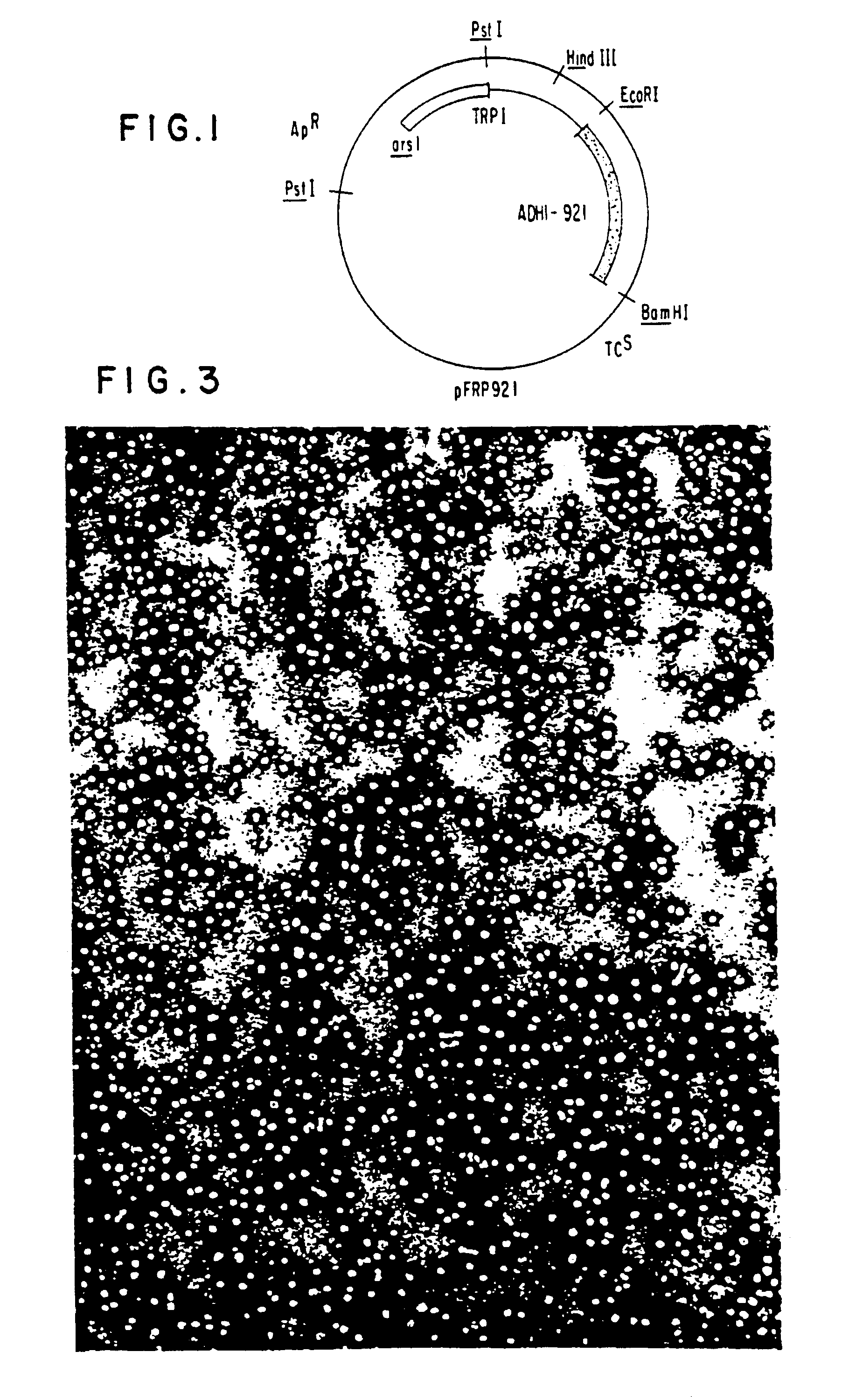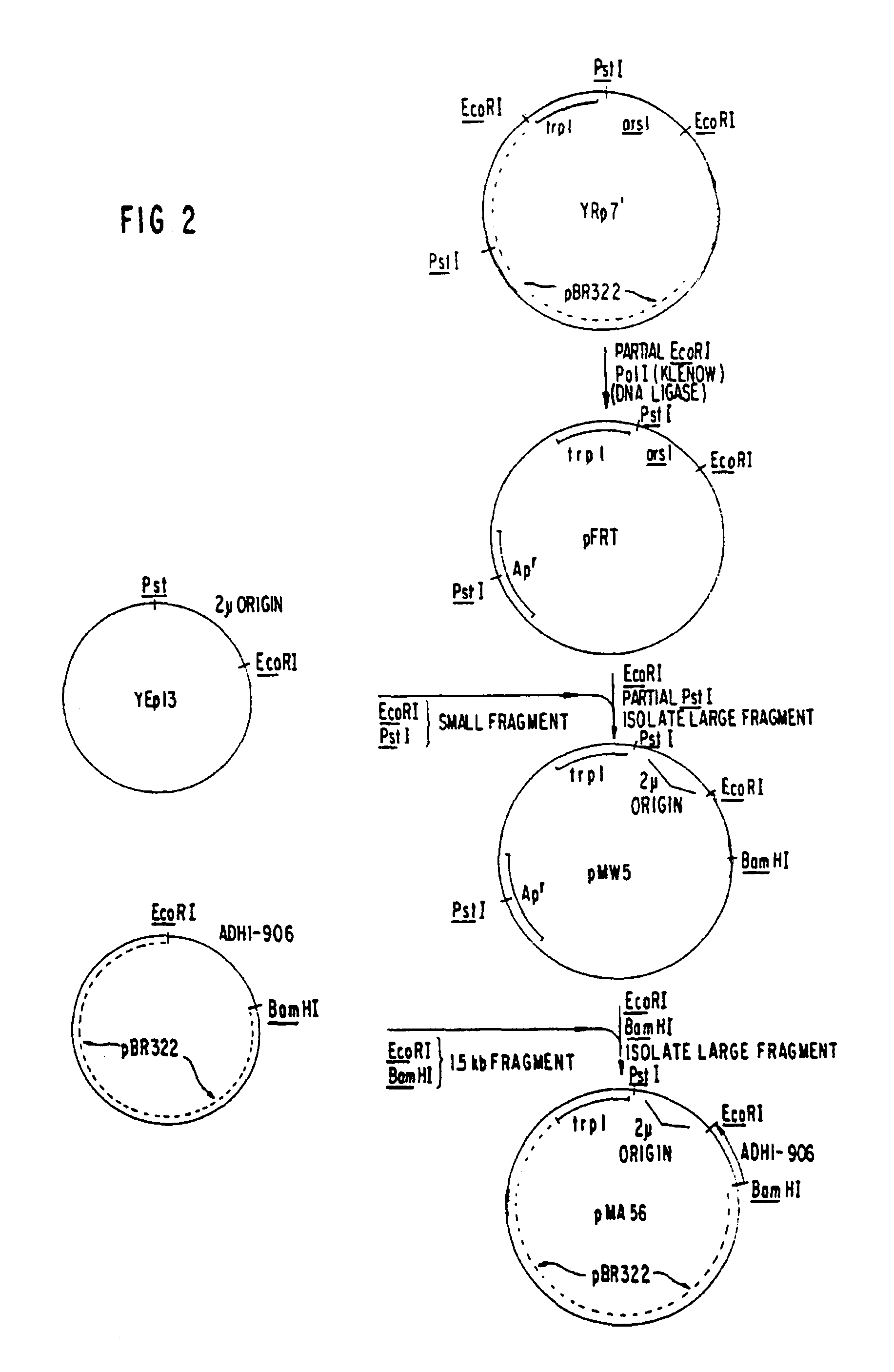Synthesis of human virus antigens by yeast
a technology yeast, which is applied in the field of biosynthesis of human hepatitis b virus (hbv) by yeast, can solve the problems of affecting the amount of material which can be prepared, and affecting the ability of vaccines to carry active viruses or other components
- Summary
- Abstract
- Description
- Claims
- Application Information
AI Technical Summary
Problems solved by technology
Method used
Image
Examples
example 2
Construction of a Yeast Plasmid Containing the S-protein Coding Region
Analysis of the nucleotide sequence of HBV DNA reported by Valenzuela, P. et al. in Animal Virus Genetics, Academic Press, New York, N.Y (1980), pp. 57-70, showed the location of the S-protein coding region. The region is contained within the TacI-HpaI fragment of 835 base pairs length. This fragment includes 26 base pairs preceding the AUG codon for the N-terminal methionine of the S-protein. (Most of the region coding for the putative presequence described supra, as well as the first two AUG codons, are missing from the TacI-HpaI fragment). The fragment also contains the entire S-protein coding region (678 bp), a TAA stop codon, and 128 bp following the stop codon. ##STR1##
Approximately 500 .mu.g of DNA from plasmid pHBV-3300 (Valenzuela, P. et al., Nature 280, 815 (1969)) were digested to completion with a combination of the restriction enzymes EcoRI and HpaI. Approximately 60 .mu.g of the fragment EcoRI-HpaI o...
example 3
Synthesis of HBsAg in Yeast
Protoplasts of the yeast-recipient strain XV610-8C or GM3 C-2, were separately incubated with DNA from each of the four plasmids, pHBS-11, pHBS-12, pHBS-16 and pHBS-20, under the transformation conditions described, and plated on agar plates in medium lacking tryptophan. Surviving colonies, transformed to tryptophan prototrophy, were isolated. To test for HBsAg synthesis, yeast strains tranformed with each of the four plasmids were separately grown in liquid cultures, in medium lacking tryptophan, and harvested in mid-log phase. The cells were collected by centrifugation, and cell extracts were prepared by grinding the cells with glass beads in a buffer of 0.01M sodium phosphate (pH 7.4) containing 0.01M beta-mercaptoethanol, and 0.1% (v / v) NP-40 detergent [polyoxyethylene(9)octaphenol]. The presence of HBV surface antigen was assayed using a radioimmunoassay kit commercially available from Abbot Laboratories, North Chicago, Ill. Qualitatively, the plasmid...
example 4
This example demonstrates removal of a 5'-untranslated segment of HBV-DNA. The DNA segment comprising the S-protein region isolated as described in Example 2 included an untranslated 26 base pair segment at the 5'-end of the coding region, lying between the promoter and the ATG start codon. The following procedure was developed to remove all, or all but one, of the bases of the 5'-untranslated region of the HBV-DNA preceding the S-protein coding region.
The plasmid pHBS-5 was digested with EcoR1 endonuclease generating a fragment of approximately 850 base pairs including the S-protein coding region and flanking 3'-and 5'-untranslated regions, terminated by EcoR1 linker oligonucleotide segments. The HBV-DNA segment was reisolated by preparative gel electrophoresis, electroeluted and divided into samples which were digested with the exonuclease Bal-31 for varying times from 0.5 to 30 minutes at 37.degree. C. The extent of exonuclease digestion was characterized qualitatively by digesti...
PUM
| Property | Measurement | Unit |
|---|---|---|
| mean diameter | aaaaa | aaaaa |
| pH | aaaaa | aaaaa |
| total volume | aaaaa | aaaaa |
Abstract
Description
Claims
Application Information
 Login to View More
Login to View More - R&D
- Intellectual Property
- Life Sciences
- Materials
- Tech Scout
- Unparalleled Data Quality
- Higher Quality Content
- 60% Fewer Hallucinations
Browse by: Latest US Patents, China's latest patents, Technical Efficacy Thesaurus, Application Domain, Technology Topic, Popular Technical Reports.
© 2025 PatSnap. All rights reserved.Legal|Privacy policy|Modern Slavery Act Transparency Statement|Sitemap|About US| Contact US: help@patsnap.com



